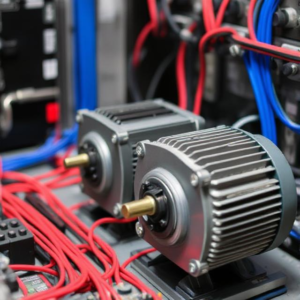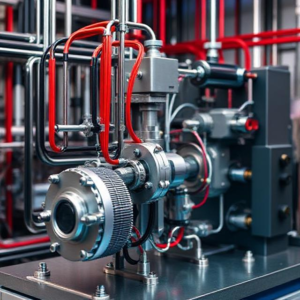Motor Drivers:
Motor drivers are components used to control and power motors, which are machines that convert electrical energy into mechanical motion (like turning wheels or spinning fans).

- What’s their job?
The motor driver acts as a bridge between a microcontroller (like a tiny computer that controls things) and the motor. It takes the small control signals from the microcontroller and uses them to control the larger power needed to run the motor. - Why do we need them?
Most motors require a lot more voltage and current than a microcontroller or small control device can provide. A motor driver amplifies those small signals from the microcontroller into the higher power signals needed to drive the motor. - How do they work?
- The microcontroller sends a low-power signal to the motor driver.
- The motor driver amplifies the signal and sends the appropriate power to the motor.
- Depending on the control signal, the motor driver can control the direction, speed, and sometimes torque (how strong the motor is).
Think of it like a light switch: the microcontroller is the person flipping the switch, and the motor driver is the actual mechanism that turns the lights on (powering the motor).
- Where are motor drivers used?
Motor drivers are found in robots, electric cars, drones, conveyor belts, and anything that needs to control motors (like controlling a fan, fan speed, or robot movement).
Control Circuits:
Control circuits are the brain behind how a motor or system behaves. They manage the behavior of the motor, such as how fast it spins, what direction it goes, or when it stops.
- What’s their job?
The control circuit makes decisions on how to drive the motor and tells the motor driver what to do. It interprets signals from sensors, switches, or other inputs to decide how the motor should behave. - Why do we need them?
Without control circuits, a motor would just run at full speed in one direction all the time. The control circuit makes sure the motor only runs when needed, at the right speed, and in the correct direction. - How do they work?
- A simple control circuit might use a PWM (Pulse Width Modulation) signal, which is a way to control the speed of the motor by adjusting how much power is sent to it.
- The circuit may include logic components that decide the direction of the motor, like turning it clockwise or counterclockwise.
- Sensors (such as position or speed sensors) can be used to give feedback to the control circuit, so it knows if the motor is doing what it’s supposed to do.
- Where are control circuits used?
Control circuits are found in things like electric fans (to change speeds), motorized toys (to control movement), and industrial robots (for precise control over movement and tasks).
How They Work Together:
Motor drivers and control circuits work closely together. Here’s how:
- The control circuit decides how the motor should behave (how fast, in what direction).
- The control circuit sends a signal to the motor driver to control the motor’s action.
- The motor driver powers the motor based on that signal.
Example:
Imagine you’re controlling a small robot. The robot has a microcontroller (the brain), a motor driver, and motors to make it move.
- The control circuit in the microcontroller reads input (like the user pressing a button or sending a signal to move forward).
- Based on that input, the control circuit tells the motor driver to send power to the motors, making the robot move forward.
Summary:
- Motor Drivers control how motors are powered and can change motor speed, direction, and force.
- Control Circuits decide how the motor should behave based on input signals (such as from a user or sensor).
- Together, they allow systems like robots or electric fans to move and function in a controlled way.











